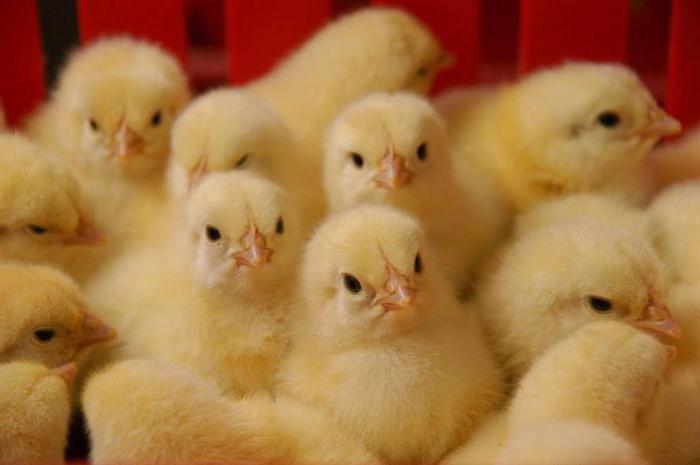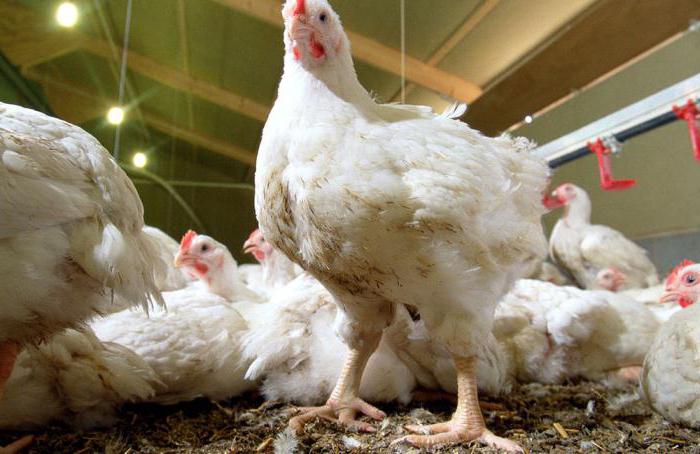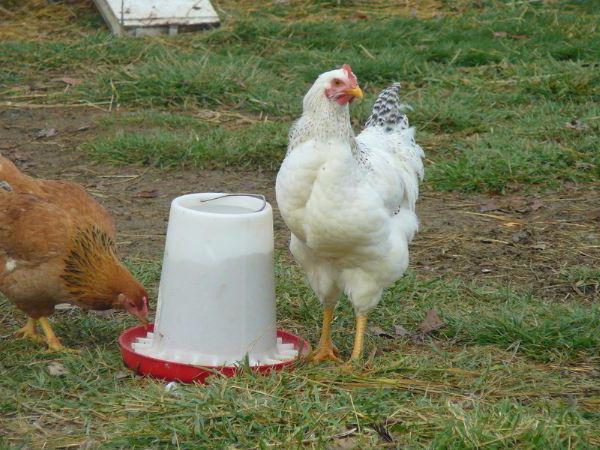Breeding broilers is a very profitable business. This bird gains weight very quickly. On a 60-70 day, each individual gains up to 1700-2000 kg. But of course, cost-effective home farm broiler rearing will only be subject to proper care of the chickens, proper feeding and keeping them.
Where to get the chicks
Young ones are acquired broilers growing at home, which is a really difficult task, usually in poultry farms. You can also buy chickens in the market. Broilers and half broilers, even at 1-5 days of age, can be easily distinguished from smaller and nimble layers. Experienced poultry farmers prefer to buy eggs in their factories and raise chickens in an incubator. Naturally, broilers are practically not bred. The fact is that in hens of most meat breeds, the instinct of motherhood is completely lost. In addition, almost all broiler breeds are hybrids. Therefore, their posterity does not inherit the excellent qualities of their parents. But if you want, you can try to put the eggs of boilers under a laying hen (if there are any, of course, on the farm).

Beginner poultry farmers are better off getting five-day chickens. The daily broiler is still too weak. Among these chickens, with the slightest errors in care, a very large lunge is observed.
First days of life
Hatched in an incubator or purchased daily chickens are planted in a clean box. To heat it, put a plastic bottle wrapped in a thick cloth. The optimum air temperature for such small chicks is 30 gr. or a little more. Also, chickens arrange round-the-clock lighting. If an incandescent bulb is used for this purpose, you can not put the bottle in the box. Heat from the lamp will be enough.
From the second week of life of chickens, air temperature can begin to lower. This should be done gradually. It will be enough to lower the temperature by 3 grams. per week, until it reaches 20 gr. In the same period, they begin to reduce lighting. The first time, "daylight hours" in chickens should decrease by 15 minutes weekly, and starting from the age of 1.5 months. - for 30 minutes. At the age of one and a half weeks, chickens can be moved to the barn (heated).
Diet of little chickens
Success in growing broilers depends primarily on their proper feeding. The diet of chickens should be as balanced and protein-rich as possible. For the first time, broilers are fed no later than 15 hours after birth. Small chickens are given millet, cottage cheese and chopped eggs. You can also use the "Start" feed for broilers.
It sometimes happens that some chickens weaken so much during hatching that they don’t want to eat anything. These must be fed with a liquid (crushed in milk) egg yolk by force. Otherwise, after five hours, such babies will die. Forced feeding should be repeated 2-3 more times. After this, the weakened chicks usually come to their senses, come to life and become as active as their brothers and sisters.

After a few days, chopped greens and grated carrots are gradually introduced into the diet of chickens. Starting from day 11, a crusher is put in the feeders, and corn flour or bran is mixed into the greens. This will prepare their body for the transfer to the grain diet.
Additives
Broiler chickens, among other things, should receive fish oil. You also need to purchase some vitamin supplements for them and feed them according to the attached instructions.It is also important to give chalk or grated shells. This should be done at least once a day. In the room where the chickens are kept, you should put a container with sand or very small pebbles.
Clean water should be at the chicks constantly. If desired, you can buy special drip drinkers. But it’s easier to just put an inverted half-liter jar of water in a saucer. Twice a week, to disinfect the stomach of the chickens, you should drink water with potassium permanganate (pink).
At first, chickens are fed every two hours. Starting from the 10th day until the age of one month - 5-6 times a day. Before the time of slaughter, food is given to broilers 4 times a day.
Adult bird feeding
The diet of young growth should consist of grain and green wet mash. In the morning at 6 o’clock the feed is given to the bird. At 10 o’clock, a green mash is placed in the feeders. At about 2-3 o'clock in the afternoon, cereals are again given. In the evening, the hens should get a mess. And at night, grain is again poured into the feeders. It is important to give food always at the same time. Skipping the same feeding is generally not allowed. Subject to these rules, the bird will gain weight faster.

The food in the feeders is imposed in such an amount that the broiler chickens eat it in 30-40 minutes. In no case should acidification of the remains of the mashings be allowed. Feeding spoiled food dramatically reduces the weight gain of broilers. Like small, adult chickens should definitely be given chalk or shell rock. As a treat, broilers are fed germinated grain. Mashkins can be slightly salted.
How to make feed for broilers yourself
Cereals should form the basis of the diet of such a bird. Feed can be purchased at the poultry farm, or you can cook it yourself. In the latter case, the ingredients are mixed in the following amounts:
- Corn Dert - 400 g;
- oatmeal - 100 g;
- wheat - 200 g;
- barley - 150 g;
- sunflower meal - 150 g;
- bone meal - 50 g;
- baker's yeast - 1-2 g.
Instead of flour in broiler feed, you can put dry reverse. There are other recipes for making grain mixtures for poultry meat breeds. In any case, the protein in the feed should contain a lot.

How to make a mess
Green chicken food can be given absolutely any. Dill, nettle, cabbage, quinoa, etc. - all this is finely chopped and mixed with bran. Also, grated root vegetables - potatoes, beets, carrots - are added to the mash. You can put slices of white bread. Be sure to add a little chalk and a vitamin mixture to this broiler feed. In summer, you can put zucchini, green pepper, and scallop in the mixers. Autumn rub apples and pears. Of course, all the ingredients used to make the mixers must be fresh. Do not use moldy bread or rotten root crops.
Feeding meat breeds of chickens really needs to be given as much attention as possible. With a balanced diet, the weight of the broiler can be added to 1 kg for every 4 kg of mixes and animal feed. For comparison: for this pigs require 6 kg, laying hens - 9 kg.
What should be the room
An ordinary wooden or brick barn is what is great for a bird like broilers. Home-grown meat chickens, however, should be produced in a dry, warm and well-ventilated area. Be sure to also arrange quality lighting. There should be a large window in the barn. You also need to hang lamps - ordinary and red. The latter can be left on all night.

Broilers can be kept both floor-standing and cellular. In the first case, a litter of sawdust, hay or straw is laid in the barn with a thickness of at least 10 cm. As it becomes soiled, its upper layer should be removed. In the chicken room, of course, you need to put a drinking bowl and a feeder. The latter should be so long that the bird can eat without a crush. Perches in a broiler barn are not satisfied.Nests also do not hang, since by the time of slaughter such a bird does not start to trot yet. You can arrange a small walk near the barn. Even broilers sometimes have to stay in the sun. But chickens should not be allowed to walk too long. Otherwise, they will not gain weight.
Broiler cages should be used spacious enough so that the bird can move freely around them. With this method, keeping chickens grow faster. The floor in the cells is fine-mesh. This is necessary so that the litter does not stay inside. In each cage, a drinker and feeder are equipped. Sometimes they are stretched along the entire block. It is best to make feeders and drinking bowls from metal. In this case, it will be much easier to care for them.
Why do chickens die
This trouble quite often happens with such a bird as broilers. Growing them at home is almost always associated with lunging. The only thing a farmer can do is keep him to a minimum. Broilers can rest for various reasons. First of all, these are:
- Lack of trace elements and vitamins. Fish veins, chalk and additives to this bird, unlike layers, should be given.
- Infection. The room where broilers are kept should be kept clean. At least the simplest ventilation should also be arranged. Some farmers are advised to flush at least a couple of times a week. Water should be changed daily. After slaughter and before launching a new batch of birds into the barn, it is absolutely necessary to carry out disinfection using the “White” product. Of course, broiler cages should also be processed. The walls of the room should be whitewashed.
- Drafts. Broiler health is not very good. And so they can catch a cold very easily. For the same reason, do not put feeders near the window. Especially in spring, autumn or winter.

Rickets
The most common problem for farmers with broilers is the fall of a bird on its feet. The cause of this phenomenon is rickets. This disease develops in chickens due to a lack of vitamin D. In order to avoid this problem and make broiler breeding more successful, you must first not forget about fish oil and chalk, and secondly, arrange sufficient lighting in the shed. Its deficiency mainly causes the deficiency of this vitamin in the body of chickens.
Broilers that should be kept clean at home should not respond very well to daily cleaning. The fact is that this bird takes many useful microelements from its own litter. Also in the diet of broilers should be a sufficient amount of greens. One grain bird, in the hope of rapid weight gain, can not be fed. Be sure to also give meat and bone meal and fodder yeast. In addition, chopped nettles mixed with crushed fish are often used as a prophylactic against rickets. It is also recommended to change the type of compound feed more often. This will prevent the development of avitominosis. If the chicken nevertheless falls to his feet, experienced farmers are advised to give him some vodka.
Lowering the wings
Another common reason home broilers die is because there is an overabundance of boiled potatoes in the diet. Many farmers do not recommend giving it to this bird at all. The fact is that from him in chickens often there is an inversion of the intestines. The sick broiler lowers its wings and, as a rule, dies.

Salmonellosis
This unpleasant disease also sometimes affects broilers. Mostly young animals suffer from it. Symptoms of it may be swollen eyes and feet, diarrhea, lack of appetite. Since salmonella is a contagious disease, an infected bird should be immediately removed from the main herd, and the remaining broilers should be given chloramphenicol by dissolving it in water. Chickens are treated for salmonellosis with streptomycin or furazolidone. In any case, the veterinarian is worth calling.
The maintenance of broilers, therefore, is a serious, troublesome and time-consuming business. Such a business will be profitable only if the bird receives maximum attention from the owner. It is especially worthwhile to approach the preparation of the diet of chickens, as well as preventing the spread of various kinds of infections in the barn.








